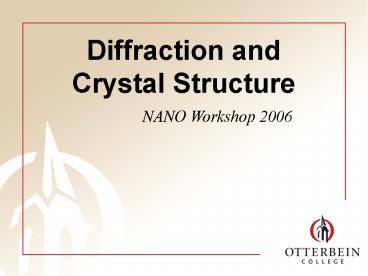Diffraction and Crystal Structure - PowerPoint PPT Presentation
Title:
Diffraction and Crystal Structure
Description:
Diffraction and Crystal Structure NANO Workshop 2006 Outline Light and X-rays Diffraction basics Determining crystal structures Activities! What is Light? – PowerPoint PPT presentation
Number of Views:316
Avg rating:3.0/5.0
Title: Diffraction and Crystal Structure
1
Diffraction and Crystal Structure
- NANO Workshop 2006
2
Outline
- Light and X-rays
- Diffraction basics
- Determining crystal structures
- Activities!
3
What is Light?
- Particle or wave? Both!
- Photons particles or quanta of light
- E hf
- Many photons ? wavelike
- A disturbance that propagates
- Usually requires a medium
4
Anatomy of a Wave
- Wavelength ?
- Frequency f
- of cycles per unit time
- Speed v ?f
- Amplitude A
5
Electromagnetic Waves
- Speed 3 ? 105 km/sec (about 186,000 mi/sec)
6
The Electromagnetic Spectrum
7
Visible Light
- The color of visible light is determined by its
wavelength - White light is a mixture of all colors
- We can separate out individual colors with a prism
8
Visible Light
- 400440 nm Violet
- 440480 nm Blue
- 480530 nm Green
- 530590 nm Yellow
- 590630 nm Orange
- 630700 nm Red
9
Superposition and Interference
- When multiple waves pass through the same place,
the total wave is obtained by adding together the
individual wave displacements (Principle of
Superposition)
10
X-Ray Diffraction
- X-rays have wavelengths comparable to atomic
sizes and spacings, about 1010 m - Crystals and molecules reflect X-rays in specific
patterns depending on their structures
X-ray diffraction pattern of myoglobin
11
Interaction of X-Rays with Atoms
- Involves the electrons, primarily
12
Fraunhofer Diffraction
- Fraunhofer incident, outgoing rays parallel
- Start with single plane of atoms (a grating)
- Wave in phase incident crests and troughs
aligned
13
Fraunhofer Diffraction
- Extra distance traveled by 2 is d sin?
- If this is an integer number of wavelengths, we
get constructive interference
1
d
?
2
14
Condition for Maxima
- where n 0, 1, 2,
- If ? is known, measuring ? tells us d
- Or if d is known we can get ?, etc.
15
Diffraction Maxima
16
Many Diffraction Centers
- All combine constructively at the specified
angles - Nice sharp maxima!
17
Bragg Diffraction
18
Braggs Law
- W. H. Bragg and W. L. Bragg, 1913 (Nobel 1915)
- Condition for constructive interference
- Diffraction from different sets of planes in the
crystal gives a picture of the overall structure
19
More Information
- Intensities of diffraction maxima can vary more
information about detailed structure - Symmetry of the crystal structure is reflected in
the diffraction pattern
20
Electron Diffraction
- Can be done with particles too, due to their wave
nature! - Direct test of the De Broglie relation
- ? h/p
- (Davisson and Germer, Thomson)
Electron diffraction image
21
Optical Transform Exercises
- Uses visible light, ? 400-700 nm
- Diffracting patterns created with features on
this scale - Illuminate with laser pointer coherent light
source
22
Discovery Slide
- Horizontal line patterns (a and c)
- Diffraction pattern is a set of vertical dots
why? - Check spacing of dots for different line spacings
- Reciprocal lattice effect
- Check spacing of dots for different wavelengths
23
Group Exercise
- Given a known wavelength of light (its shown on
the laser pointer), determine the line spacing of
the Discovery Slide pattern a.
24
Other Exercises
- Explore the symmetry relations between
diffraction patterns and the atomic
arrangements - Look for variations in intensity for diffraction
maxima when does this occur?































